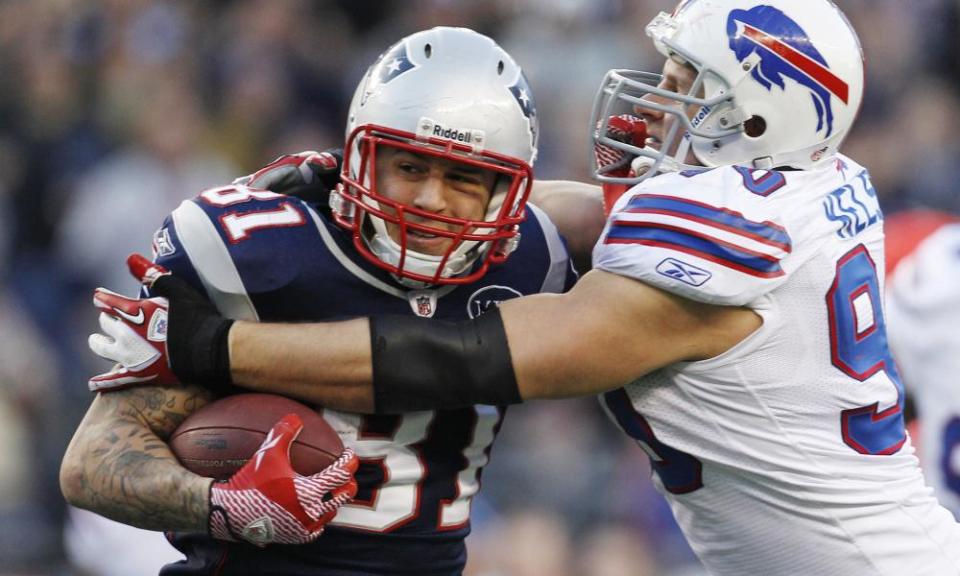Aaron Hernandez's CTE diagnosis heightens the NFL's brain trauma crisis
On Thursday it was revealed a 27-year-old with 44 career NFL games had the brain of a 67-year-old man. Will the league do anything about it?

We probably didn’t need Aaron Hernandez’s attorney to declare Thursday that his dead client had the brain of a near-70-year-old with severe dementia. Too many decisions the one-time New England Patriots star made before killing himself earlier this year at 27 made no sense. Experience has told us that when young, wealthy football players start making erratic life choices, there is probably a physical reason lurking inside their skulls.
The question is: what will anyone do about it?
The time for hand-wringing about the role football plays in the degenerative brain disease chronic traumatic encephalopathy is over. Science is only beginning to understand CTE. It’s going to take decades to assess how much the pounding of football helmets affects players’ brains. But enough is known now to say that dire measures need to be taken.
For more than 10 years, neurologists have been drawing a connection between the blows players take to their heads and the growth of tau deposits that signal CTE. They have measured the power of enough hits to the head and looked at enough slides of brain tissue to say football has some culpability in the sudden aging of otherwise healthy men’s brains.
Even the NFL has conceded this fact.
And yet for all the talk about better helmets or smarter tackling or trying to get players to not turn themselves into human torpedoes when going for the hit, no one wants to deal with the bomb ticking inside their helmets – the one that makes sane, smart men go crazy. We get lots of chatter. We get promises about brain study initiatives, but we don’t get the kind of action needed to maybe save players’ lives.
A few days ago the Canadian Football League and the league’s players union together announced that the league is eliminating full-contact practices during the season.
“It was clear we had an opportunity to get this out and do something proactive for player safety,” CFL commissioner Randy Ambrosie told the CBC while unveiling the new policy.
The move isn’t as significant as it sounds. CFL teams only have 17 full-contact practices during the season which amounts to slightly less than one a week - NFL teams are allowed roughly the same number. But it’s a message that the CFL and their players’ union is committed to at least addressing the root of the problem – a message the NFL has said it doesn’t expect to match.
An impression is stuck in people’s minds that the biggest cause of CTE is the big, booming hits players take in games, those where they are smashed to the ground or knocked out completely. It’s an impression built in the earliest days of the discovery of CTE in dead football players and further fed by the movie Concussion, which tells the story of how a link between CTE and football was first made. But most research now is focused less on those crashing blows but on the seemingly benign day-to-day cracking of helmets in practices and games.
It might not seem like much to watch a football practice and watch players bump heads over and over and half speed – or even to see them do the same with more power in games. And yet each crack of hard plastic against hard plastic triggers some kind of trauma. The wounds might be small at first but they build up over time. At some point the damage can reach dangerous levels. This, scientists suspect, may be where the real trouble lies. An invisible killer.
The NFL has been slow to embrace CTE discussion, perhaps for obvious reasons. Litigation from former players has cost the league close to $1bn in settlements. Hernandez’s attorney Jose Baez said Thursday he is suing the Patriots and NFL on behalf of the player’s young daughter. The league seems to operate with litigation in mind, employing fleets of lawyers to counter potential lawsuits related to many of their decisions.
In some ways the NFL is right in raising questions about how much CTE affects their players. It will take years for scientists to properly study the disease that can only be detected posthumously. The brains doctors have been given to study have come from players like Hernandez, whose behavior troubled relatives enough to allow researchers to take chunks of their dead loved one’s brain. Brains of the thousands of ex-players who have lived normal lives have not been examined, meaning CTE studies are self-selective and perhaps misleading.
CTE can’t be the reason for everything that goes wrong in a player’s life. Sometimes bad behavior is just bad behavior. We can’t say CTE led Hernandez to kill Odin Lloyd in 2013, the crime for which he was sentenced to life in prison. But CTE is something and that something is serious.
It will take more than cutting full-contact practices during the season to reduce the risk of CTE, Maybe teams at all levels have to eliminate nearly all their contact practices. Maybe football has to reinvent itself completely. But at least the CFL has taken a positive action to deal with the menace that has destroyed lives.
A small step, perhaps, but a step nonetheless.
The time has come to stop listening to the lawyers and take many steps more.

